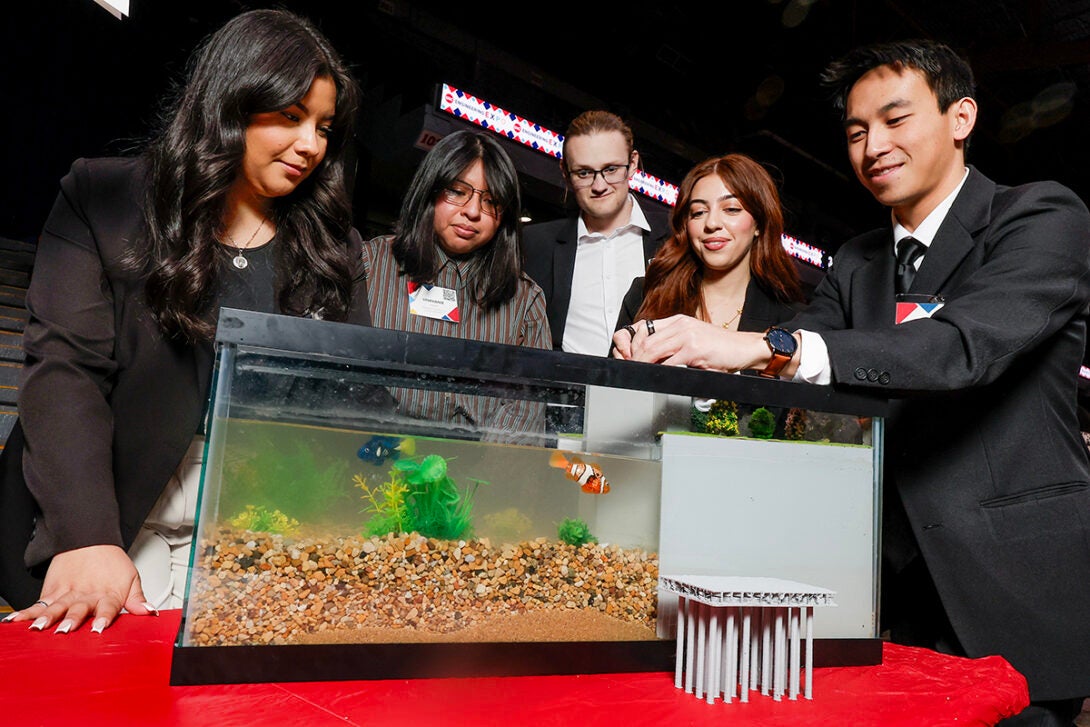CME seniors show engineering prowess at annual expo
1

In April, seniors throughout the College of Engineering presented their final projects during the 2025 Engineering Expo.
The event is the culmination of two semesters of hard work in the Senior Design course, which challenges teams of undergraduate students to solve real-world engineering issues using research, creativity, and the skills they developed at UIC.
This year, 18 teams from civil, materials, and environmental engineering took on projects related to environmental, structural, transportation, and water resources engineering.
Two teams from the department were named Best In Show with the projects that looked at a lock floor remediation plan for a harbor in Chicago and “Green Skatepark Facility for Flood Mitigation
USACE Chicago Harbor Lock Floor Remediation Plan
The team of Ashley Astorga, Stephanie Cuzco, Eve Maali, Joseph Matusiewicz, and Sicong Pei captured the judges’ attention with “USACE Chicago Harbor Lock Floor Remediation Plan.”
The lock helps with flood control and water quality in the Chicago Area Water System, and plays a crucial role in supporting commercial traffic, recreational boating, and government operations, making it a critical piece of infrastructure for the Midwest.
The project calls for the redesign of the concrete floor panels in the Chicago Harbor Lock, which have weakened due to extreme conditions and heavy vessel traffic. The floor is crucial in supporting operations by sealing the chamber, preventing leaks, and providing a stable foundation that withstands water pressure and dynamic forces.
“The floor helps prevent erosion, sediment buildup, and blockage while working with the gates and walls to regulate water flow. Without the floor, the lock would require costly maintenance and face operational risks,” Ashley Astorga said.
The students developed a new design that reduces the number of floor slabs while incorporating micropile anchorage and steel reinforcement to prevent future lifting.
“The design is optimized for the ease of future repairs, ensuring efficient maintenance if needed. It is engineered to be efficient, cost-effective, and environmentally sustainable,” Astorga said.
In addition, the team estimated the cost to redesign and implement a new floor to be $30 million, which would be more cost effective than making constant repairs that could be just as high.
Green Skatepark Facility for Flood Mitigation
The team of Ash Antunez, Max Edman, Nathan Kis, Tomek Kowalczyk, and Caden Slovacek presented “Green Skatepark Facility for Flood Mitigation,” which proposed a design and developed preliminary plans, specifications, and estimates for the RAGE Smart Skatepark project at Brown Memorial Park in Chicago’s Chatham neighborhood.
The goal was to createIllinois’ first “green skatepark” by implementing sustainable stormwater management solutions with community-focused recreational facilities, while addressing “the challenges of urban flooding and the unequal distribution of recreational spaces, which disproportionately impact minority communities.”
“We incorporated an ADA permutable ramp, storm water planters, as well as a rain garden, which infiltrates the storm water into the soil through the use of native plantings. We also incorporated a detention basin, which collects all the water to temporarily hold it until it infiltrates back into the sewer very gradually. We also included a steel shade structure as well as making our projects as accessible to as many community members as possible,” Antunez said.
“The skatepark is constructed with reinforced concrete and guides runoff through depressed regions that double as temporary water detention areas during intense rainfall,” Slovacek added.
By addressing environmental and social challenges, the skatepark has the potential to improve neighborhood resilience, provide safe and vibrant recreational opportunities, and serve as a model for sustainable urban development.
In addition to providing a project that could potentially help a neighborhood, the students took away lessons that prepared them for the professional world.
“In the classes, we really focus on the design and the concepts and the engineering, which I think is what you have to focus on in the school,” Slovacek said. “But working with all these agencies, learning about professionalism, finding where the utilities are for a project? These types of questions are not answered in the classroom.”